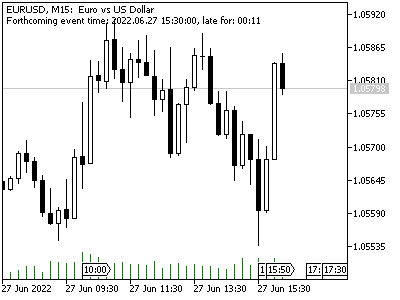- Basic concepts of the calendar
- Getting the list and descriptions of available countries
- Querying event types by country and currency
- Getting event descriptions by ID
- Getting event records by country or currency
- Getting event records of a specific type
- Reading event records by ID
- Tracking event changes by country or currency
- Tracking event changes by type
- Filtering events by multiple conditions
- Transferring calendar database to tester
- Calendar trading
Reading event records by ID
Knowing the events schedule for the near future, traders can adjust their robots accordingly. There are no functions or events in the calendar API ("events" in the sense of functions for processing new financial information like OnCalendar, by analogy with OnTick) to automatically track news releases. The algorithm must do this itself at any chosen frequency. In particular, you can find out the identifier of the desired event using one of the previously discussed functions (for example, CalendarValueHistoryByEvent, CalendarValueHistory) and then call CalendarValueById to get the current state of the fields in the MqlCalendarValue structure.
bool CalendarValueById(ulong id, MqlCalendarValue &value)
The function fills the structure passed by reference with current information about a specific event.
The result of the function denotes a sign of success (true) or error (false).
Let's create a simple bufferless indicator CalendarRecordById.mq5, which will find in the future the nearest event with the type of "financial indicator" (i.e., a numerical indicator) and will poll its status on timer. When the news is published, the data will change (the "actual" value of the indicator will become known), and the indicator will display an alert.
The frequency of polling the calendar is set in the input variable.
input uint TimerSeconds = 5; |
We run the timer in OnInit.
void OnInit()
|
For the convenient output to the event description log, we use the MqlCalendarRecord structure which we already know from the example with the script CalendarForDates.mq5.
To store the initial state of news information, we describe the track structure.
MqlCalendarValue track; |
When the structure is empty (and there is "0" in the field id), the program must query the upcoming events and find among them the closest one with the CALENDAR_TYPE_INDICATOR type and for which the current value is not yet known.
void OnTimer()
|
The found event is copied to track and output to the log. After that, every call to OnTimer comes down to getting updated information about the event into the update structure, which is transferred to CalendarValueById with the track.id identifier. Next, the original and new structures are compared using the auxiliary function StructCompare (based on StructToCharArray and ArrayCompare, see the complete source code). Any difference causes a new state to be printed (the forecast may have changed), and if the current value appears, the timer stops. To start waiting for the next news, this indicator needs to be reinitialized: this one is for demonstration, and to control the situation according to the list of news, we will later develop a more practical filter class.
else
|
While waiting for the event, the indicator displays a comment with the expected time of the news release and how much time is left before it (or what is the delay).

Comment about waiting or being late for the next news
It is important to note that the news may come out a little earlier or a little later than the scheduled date. This creates some problems when testing news strategies on history, since the time of updating calendar entries in the terminal and through the MQL5 API is not provided. We will try to partially solve this problem in the next section.
Here are fragments of the log output produced by the indicator with a gap:
CalendarValueHistory(values,TimeCurrent(),TimeCurrent()+(60*60*24)*3)=186 / ok Started monitoring 156045 [id] [event_id] [time] [period] [revision] » 156045 840020013 2022.06.27 15:30:00 2022.05.01 00:00:00 0 » » [actual_value] [prev_value] [revised_prev_value] [forecast_value] [impact_type] » » -9223372036854775808 400000 -9223372036854775808 0 0 » » [importance] [name] [currency] [code] [actual] [previous] [revised] [forecast] » "Medium" "Durable Goods Orders m/m" "USD" "US" nan 0.40000 nan 0.00000 ... Alert: News 156045 changed New state of 156045 [id] [event_id] [time] [period] [revision] » 156045 840020013 2022.06.27 15:30:00 2022.05.01 00:00:00 0 » » [actual_value] [prev_value] [revised_prev_value] [forecast_value] [impact_type] » » 700000 400000 -9223372036854775808 0 1 » » [importance] [name] [currency] [code] [actual] [previous] [revised] [forecast] » "Medium" "Durable Goods Orders m/m" "USD" "US" 0.70000 0.40000 nan 0.00000 Timer stopped
|
The updated news has the actual_value value.
In order not to wait too long during the test, it is advisable to run this indicator during the working hours of the main markets, when the density of news releases is high.
The CalendarValueById function is not the only one, and probably not the most flexible, with which you can monitor changes in the calendar. We will look at a couple of other approaches in the following sections.